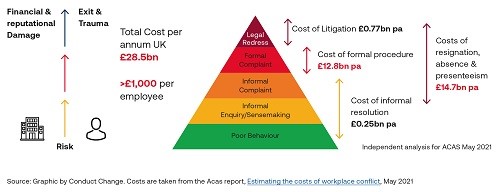Workplace bullying and harassment can have a devastating effect on an employee’s mental and physical wellbeing, but many employers make the mistake of simply reacting to complaints as they arise, rather than focusing on cultural and organisational changes that will prevent bullying in the first place.
Features
Beating the bullies: why a risk management approach is vital
Every day at work people are exposed to bullying and harassing behaviours. We know that work-related stress is one of the highest causes of absence in the workplace, and research suggests that bullying and harassment are attributable for between one-third and half of all absences.
So, what is workplace bullying, and why does it appear to be on the rise? More importantly, what can we do to help prevent it in the first place?
Let’s look at how we define bullying. Bullying behaviours cover a wide spectrum, from moments of incivility and rudeness up to gaslighting and physical assaults leading to psychiatric and physical injury. Bullying behaviours can be verbal, physical and psychological. They may be overt or covert; in full sight or behind closed doors. They can occur in person or online. The impact can vary between individuals, making this a difficult area to define. This is why we need to consider the impact of the behaviours; the way in which they have been received and the potential harm to health, and even to life, that may occur as a result.
 Bullying can present as offensive, intimidating, malicious or insulting behaviour. Photograph: iStock
Bullying can present as offensive, intimidating, malicious or insulting behaviour. Photograph: iStock
In the UK, although there is no legal definition of bullying, ACAS (Advisory, Conciliation and Arbitration Service) defines bullying as “unwanted behaviour from a person or group that is either:
- Offensive, intimidating, malicious or insulting
- An abuse or misuse of power that undermines, humiliates, or causes physical or emotional harm to someone.”
Harassment is defined in the Equality Act 2010 and is linked to a protected characteristic (age, race, religion or belief, sex, pregnancy and maternity, sexual orientation, gender reassignment, marriage and civil partnership, and disability).
The International Labour Organization’s (ILO’s) C190 – Violence and Harassment Convention, 2019 (No. 190)2 came into force in the UK on 7 March 2023, “recognising the right of everyone to a world of work free from violence and harassment…”. The term “violence and harassment” here refers to “a range of unacceptable behaviours and practices, or threats thereof, whether a single occurrence or repeated, that aim at, result in, or are likely to result in physical, psychological, sexual or economic harm”.
These definitions all refer to the harm that can be caused, and a move away from intent towards a focus on the impact of bullying behaviours.
The scale of bullying and harassment at work
When the Chartered Institute of Personnel and Development (CIPD) published its Managing Conflict in the Modern Workplace report in January 2020, it specifically asked about personal experience of bullying, harassment (not sexual) and sexual harassment separately. Its findings showed that four per cent were sexually harassed, eight per cent experienced other forms of harassment and 15 per cent have experienced non-discriminatory bullying at work in the past three years – so 27 per cent of the workforce felt bullied or harassed. A quarter of employees also think challenging issues like bullying and harassment are swept under the carpet in their organisation.
In 2022, the ILO–Lloyd’s Register Foundation–Gallup global survey of experiences of violence and harassment at work found that around one-third of workers had experienced more than one of the main forms (physical, psychological and sexual). It also found:
- Nearly one in ten (8.5 per cent or 277 million) experienced physical violence and harassment at work in their working life
- Psychological violence and harassment was the most common form of violence and harassment reported by both men and women: nearly one in five (17.9 per cent or 583 million)
- One in 15 (6.3 per cent or 205 million) experienced sexual violence and harassment (8.2 per cent of women compared with 5.0 per cent of men.
What causes bullying?
Bullying can be caused by a number of different factors – from someone having experienced trauma themselves and influencing their behaviours, to adopting the behaviours they see being rewarded in the environment in which they work. It can also be that quite simply no one has told the individual that their behaviours are not acceptable and that’s because when behaviours go unchallenged, they become accepted as the norm. Most of our behaviours develop through observation, not through being given a code of conduct during our onboarding into a new role.
 Bullies can behave the way they do because they are simply adopting what they see being rewarded in their workplace. Photograph: iStock
Bullies can behave the way they do because they are simply adopting what they see being rewarded in their workplace. Photograph: iStock
Accepted behaviours are not the same as acceptable behaviours
Bullying behaviours may also stem from an increased level of stress, which includes difficulties outside of work, as well as a result of work-related pressures. This is where we need to consider the many opportunities for bullying to occur as a result of working practices in an organisation.
Particular examples might include excessive demands such as overloading, or removing responsibility from, a particular member of the team, or setting unrealistic expectations and targets. Is the information that is needed to do the job being provided? Are employees being empowered to contribute or are they being micromanaged? Are people being given the right training and equipment to be able to do their jobs effectively?
Are positive working relationships being developed or is there favouritism? Do we see examples of copying people into emails unnecessarily to try and force a result or humiliate others? How are hybrid working environments affecting relationships? Are command and control management styles still in play? Are changes being effectively communicated? Is there clarity around employees’ roles?
These are all areas which are most likely to lead to a lack of psychological safety, and anyone familiar with the HSE stress risk management assessment process will recognise the categories of Demands, Control, Support, Relationships, Role and Change. Experience shows that stress risk assessments are mainly used (if at all) when someone has been absent and is returning to work – after the stress has occurred. Why are they not being used to identify and mitigate potential risks much earlier?
At a strategic level, there may be financial and business model pressures. A common complaint is behaviours being ignored in favour of commercial contributions. A key factor often cited is a lack of personal development for people promoted into management and leadership, particularly in this time of adapting to hybrid working models and the challenge of managing remotely. The increase in online working has blurred the boundaries between home and work; social and professional; and subsequently, the way in which people behave.
Speaking up – and the consequences
Employers have a legal duty to:
- Provide a safe workplace and system of work
- Provide a suitable working environment
- Maintain a relationship of mutual trust and confidence.
There is often an assumption that bullying must be covered by health and safety law as a result of the duty of care established for employers. However, there is yet to be a real shift to prevention for psychological safety in the same way as physical safety.
![]() Organisations trying to adopt a ‘speak up culture’ will find their efforts ineffective if action has not been taken to mitigate the risk of speaking up. Photograph: iStock
Organisations trying to adopt a ‘speak up culture’ will find their efforts ineffective if action has not been taken to mitigate the risk of speaking up. Photograph: iStock
In many cases, employers’ current policies and procedures place the onus on asking people to speak up when they feel bullied or harassed. The trend is to create a ‘speak up’ culture with champions and advisors in place. Whistleblowing policies tell us we can speak up confidentially, and UK law allows cases for harassment, and indirectly, bullying to be taken through either employment law or civil law.
And yet, time and time again, we see the person raising the complaint being absent from the workplace; losing their job; being silenced; being punished for speaking up.
An individual’s situation is five times more likely to get worse than it is to improve after formally reporting their workplace bullying, according to Speak Out Revolution, and their evidence suggests that only four per cent of workplace bullying allegations achieve a full resolution. Policies and procedures are not working – they are adversarial and not fit for purpose. Events are considered reactively and only at an individual level. We must shift to an organisational, preventative model if we are to see real change.
Organisations trying to adopt a ‘speak up culture’ will find their efforts ineffective if action has not been taken to mitigate the risk of speaking up by changing the working practices that are most likely to lead to complaints in the first place. Many of the cultural changes that prevent workplace bullying also create not only a psychologically safer environment, but also enhance creativity, innovation and competitiveness.
 Nicki Eyre: "We must shift to an organisational, preventative model if we are to see real change."
Nicki Eyre: "We must shift to an organisational, preventative model if we are to see real change."
Supporting employees who experience bullying and harassment
Research demonstrates that workplace bullying injures the physical and mental health of employees, ranging from mild stress-related impacts to severe presentations consistent with trauma. It can create a brain injury leading to post-traumatic stress disorder (PTSD). Evelyn Field (2012) asserts that Workplace Bullying Trauma (WBT) presents with a very clear constellation of symptoms, different to other trauma.
The categories of symptoms are physical, psychological, cognitive, social and personality change. Many organisations offer an Employee Assistance Programme (EAP) which may include counselling, signposting to other organisations, or even Mental Health First Aiders at work. However, they must be trained to recognise trauma and to refer to more specialist services as appropriate. Damage can be very real and very long lasting. Training in a trauma-informed approach is recommended for anyone who will be involved in a bullying or harassment case at any stage to reduce the risk of secondary harm and further injury.
However, the best way to support employees is to prevent the harm from occurring in the first place.
A preventative approach
We have already seen how the current response to workplace bullying complaints leads to an increased risk of harm. Too often, employers move to formal reporting before exploring earlier intervention models.
Research shows that no single intervention is known to be a ‘magic bullet’, therefore multiple interventions need to be embedded across all areas of the organisation.
This must no longer be seen as just an HR problem. Anyone with responsibility for the health and wellbeing of the people in the organisation needs to be involved (which is basically everybody), and Behavioural Risk Management should be a regular Board level agenda item.
Conduct Change’s 3R’s Model of Dynamic Conduct Change™: Recognise, Resolve and Recover, uses a risk management approach to the prevention of workplace bullying, supporting organisations to change from a reactive to a proactive culture to prevent bullying. There needs to be action, not just policies and procedures, regulation and compliance. There is a need for a shift to focus on the positive behaviours that are accepted, and how these will be recognised and rewarded.
Conflict will still occur but there are many approaches to resolution available to prevent escalation. Early intervention is critical, and formal processes must be a last resort. There is a need to redefine conflict to make it about the subject not the person.
If a case has reached formal processes, and early resolution has failed, then the employer needs to switch their focus to recovery. This should include helping individuals recover their confidence and trust as well as supporting the organisation to rebuild its reputation, especially if information has been shared online.
There are both moral and competitive drivers to adopting such an approach, as we know that there is both a human and a business cost to workplace bullying, with an increase in risk to both parties as events escalate. In 2021, according to Acas, the estimated annual cost of conflict to the UK economy was £28.5 billion, or just over £1,000 per employee. The majority of these costs are associated with the costs of resignation, absence and presenteeism aligned with the use of formal procedures, reinforcing that there is a critical time to intervene – namely before formal processes are reached or have begun.

The graphic above (featuring cost estimates from Acas) shows how the costs align to each stage of the informal and formal processes. The risk to the individual of psychiatric harm substantially increases as we move up this triangle, and the risk to the organisation also increases. Bullying is not just about two people. It affects teams, morale, reputation, productivity and motivation. It affects the bottom line.
We see this mirrored in the guidance now being issued by regulatory bodies with an increased focus on values, conduct and culture, alongside a move to improve workplace health and wellbeing by decreasing psychosocial risks.
In June 2021, the first global standard giving practical guidance on managing psychological health in the workplace, ISO 45003 Psychological health and safety at work – Guidelines for managing psychosocial risks, was published. This voluntary code of practice provides guidance on the management of psychosocial risk as part of an occupational health and safety management system, including risk management for social factors including Civility and respect; Violence at work; Harassment; and Bullying and victimisation.
In conclusion
It’s time for employers to take a look at what they’re actually doing to prevent workplace bullying and whether it’s working. We know that many organisations are already doing work in this area but it’s not always effective and it’s primarily reactive.
Where are the gaps in your organisation’s work? What are you doing to help your employees recognise the behaviours that are valued and those that are not acceptable? What are you doing to help resolve issues when they arise through early intervention? How do you prevent them from escalating into workplace bullying cases? There will always be conflict in the workplace, so how are you ensuring that this is healthy and used to generate change, innovation and creativity, making you more competitive as an organisation? And on those occasions when it does go wrong, what are you doing to help the individuals and teams recover and to ensure that your organisation learns and adapts to ensure things are different moving forward?
Nicki Eyre, founder and managing director of Conduct Change, has experienced both opportunity and adversity during her career, including her own experience of feeling bullied at work.
She founded Conduct Change as a result of her passion for working with individuals and businesses to prevent and resolve workplace bullying, with a mission to end workplace bullying through the development of meaningful prevention activities for organisations to ensure that everyone feels heard, valued and respected in the workplace.
She also leads the work of the Stop Hurt at Work campaign as they research and campaign for the implementation of effective routes to redress for individuals, both in terms of approach and legislation, as well as supporting individuals to move on when they are struggling emotionally. Nicki is a Member of the International Association on Workplace Bullying & Harassment.
For more information see: conductchange.co.uk
@Conduct_Change
linkedin.com/company/stophurtatwork
The United Against Workplace Bullying 2023 conference, organised by Conduct Change and the Stop Hurt at Work campaign, will be held online on 14–15 November. See: conductchange.co.uk/uawb-conference
FEATURES

Sedentary working and how to combat the ‘sitting disease’
By Gavin Bradley, Active Working on 05 April 2024
Prolonged and excessive sitting poses a major risk to our health, but the Get Britain Standing campaign and On Your Feet Britain Day on 25 April are a great way of encouraging workers to sit less and move more.

Company culture and wellbeing: a crucial link
By Bex Moorhouse, Invigorate Spaces on 05 April 2024
Investing in measures to support worker wellbeing will be ineffective unless the company culture genuinely incorporates values like teamwork, involvement, flexibility and innovation.

Office design and culture: happier and healthier staff – or the opposite?
By Guy Osmond, Osmond Ergonomics on 03 April 2024
Applying ergonomic principles to workstation set-ups and ensuring the physical environment supports neurodivergent people are just some of the ways of creating an office where everyone can thrive, but a supportive and positive organisational culture is vital too.


